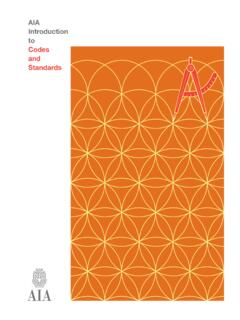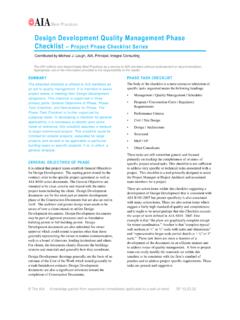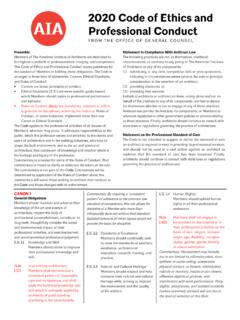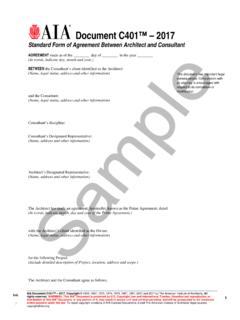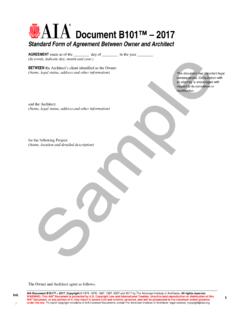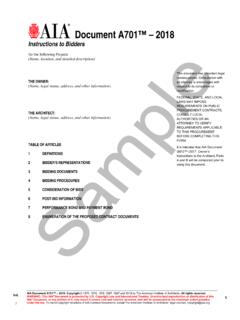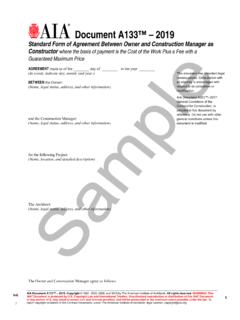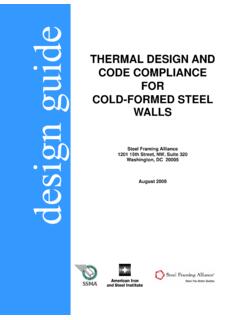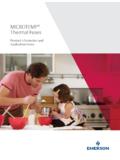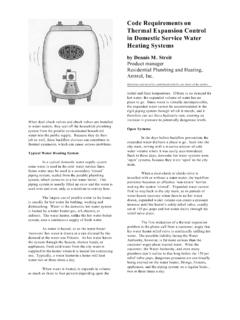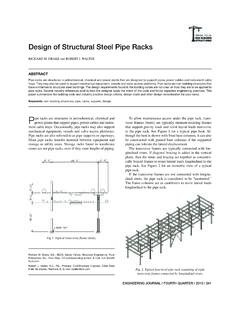Transcription of Building Thermal Envelope Provisions in ASHRAE 90.1-2013 ...
1 Commercial Energy Standards and Codes Building Thermal Envelope Provisions in ASHRAE IECC PNNL-SA-112125 PAM COLE, PNNL DAVE CONOVER, PNNL Building Energy Codes Program AIA Provider #: I014 Course # CED2015 August 12, 2015 Building Thermal Envelope Provisions in ASHRAE IECC This program is registered with the AIA/CES for continuing professional education. As such, it does not include content that may be deemed or construed to constitute approval, sponsorship or endorsement by the AIA of any method, product, service, enterprise or organization. The statements expressed by speakers, panelists, and other participants reflect their own views and do not necessarily reflect the views or positions of The American Institute of Architects or of AIA components, or those of their respective officers, directors, members, employees, or other organizations, groups or individuals associated with them.
2 Questions related to specific products and services may be addressed at the conclusion of this presentation. 2 Course Description and Learning Objectives Commercial Energy Standards and Codes Building Thermal Envelope Provisions in ASHRAE IECC the different compliance paths and methods that apply to the Building Thermal Envelope of commercial buildings. the differences between new construction, additions, alterations, and repairs. familiar with the mandatory requirements for the Building Thermal Envelope . the differences between and 2015 IECC Building Thermal Envelope Provisions .
3 Learning Objectives 3 What is covered in the scope of the documents? 4 ANSI/ ASHRAE /IES 2015 IECC Scope New buildings and their systems New portions of existing buildings and their systems New systems and equipment in existing buildings Alterations, renovations and repairs of existing buildings, including replacement of portions of buildings Conversion of spaces that change space conditioning ( )/cause a non-conditioned space to become conditioned (IECC) Changes in occupancy or use that cause an increase in demand for energy (IECC)/involving a change in equipment or systems ( )
4 New equipment or Building systems specifically identified in the standard that are part of industrial or manufacturing processes Does not apply to one and two family dwellings and multi-family residential buildings less than 3 stories in height above grade 5 Section Installation of storm windows or glazing panels Replacement of glazing in existing sash and frame Alterations to Envelope cavities provided they are insulated to full depth with a nominal per in. Wall and floor alterations where no new cavities are created Roof recovering Removal and replacement of roof membranes Replacement of existing doors Replacement of existing fenestration, provided area of replacement is no more than 25% of total fenestration area 2015 IECC C503 Storm windows over existing fenestration Surface-applied window film installed on existing single pane Exposed, existing ceiling, wall or floor cavities if already filled with insulation Where existing roof.
5 Wall or floor cavity isn t exposed Roof recover Reroofing for roofs where neither sheathing nor insulation exposed Insulate above or below the sheathing Roofs without insulation in the cavity Sheathing or insulation is exposed Alterations Exceptions to the Builidng Thermal Envelope Provisions 6 What are the different paths to compliance? 7 ANSI/ ASHRAE /IES 2015 IECC Options and Compliance Paths 2 C402 - Envelope C403 - Mechanical C404 - SWH C405 - Lighting C406 Pick One Eff. HVAC Performance Reduced Lighting Power Density Enhanced Lighting Controls 1 ASHRAE 3 C407 Total Building Performance ** Air Leakage Provisions applicable to all mechanical systems C404 - SWH Lighting Mandatory Sections 2015 IECC - Prescriptive 2015 IECC - Performance On-site Supply of Renewable energy Dedicated Outdoor Air System High Eff.
6 Service Water Heating ** Building energy cost to be 85% of standard reference design Building - Prescriptive - Performance 8 Can you summarize key Envelope changes from the prior editions? 9 ANSI/ ASHRAE /IES 2015 IECC 2012 IECC ANSI/ ASHRAE /IES Highlights of Changes from Building Thermal Envelope Changes references from clerestory to roof monitor (Chapter 5) Adds low-e requirements for storm window retrofits ( ) Clarifies roof insulation requirements, differentiating between roof recovering (on top of existing roof covering) and replacement of roof covering ( ) Relaxes air leakage requirements for high-speed doors for vehicle access and material transport ( ) Adds specific vestibule requirements for large (40K sf+) spaces ( )
7 Requires roof solar reflectance and Thermal emittance testing to be in accordance with the CRRC-1 Standard ( ) 10 Highlights of Changes from Building Thermal Envelope Reduces the area threshold at which skylights and daylighting controls are required ( ) Terms - Modifies daylighting definitions Fenestration criteria revised by adding consideration of orientation More stringent opaque and fenestration criteria Appendix C on Envelope tradeoffs rewritten to use a simulation based approach 11 For more detail on differences between and and their impact on energy use see 12 More stringent Thermal performance requirements for opaque assemblies and
8 Fenestration Fenestration criteria revised by adding consideration of orientation Requirements for complying prescriptively when WWR>30% but less than 40% are changed. Controlled daylighted area 50% of floor area in 2012 IECC 50% of net floor area (NFA) for 1-2 story and 25% of NFA for taller buildings in 2015 IECC A new component performance alternative (UA-based trade-off) Highlights of 2015 IECC Changes from 2012 IECC Building Thermal Envelope 13 Changed the 'trigger' at which a minimum area of the roof be skylights is required From 10K sf to sf.
9 And added more space types to the scope Extended continuous air barrier to all climate zones except for 2B (hot/dry parts of TX, AZ and CA) Now allow doors with an air curtain to satisfy the vestibule requirements Highlights of 2015 IECC Changes from 2012 IECC Building Thermal Envelope For more detail on the changes in the IECC see Chapter 5 General (Section ) Scope Space-Conditioning Categories Envelope Alterations Climate Compliance Paths (Section ) Simplified Building (Section ) Not Used Mandatory Provisions (Section )
10 Insulation Fenestration and Doors Air Leakage Prescriptive Building Envelope Option (Section ) Opaque Areas Fenestration Building Envelope Trade-Off Option (Section ) Submittals (Section ) Product Information and Installation Requirements (Section ) Structure of and 2015 IECC Building Thermal Envelope Provisions 2015 IECC Section C402 General (Section ) Opaque, roof SR and TE, fenestration and air leakage Low-energy buildings Equipment buildings Insulation component R-value method Assembly U, C or F factor method Component performance method Specific BTE insulation requirements (Section ) Roof SR and TE (Section ) Fenestration (Section ) Air leakage (Section ) Opaque Areas Fenestration 14 Separate Building Thermal Envelope component requirements apply to different types of conditioned spaces Nonresidential Residential ( )
